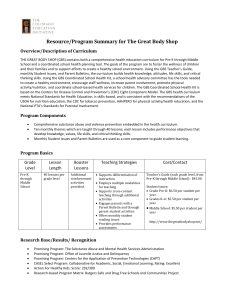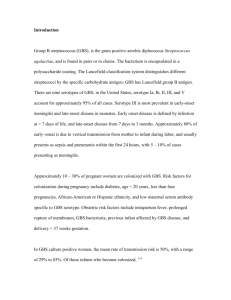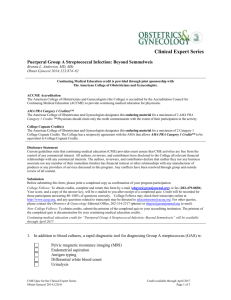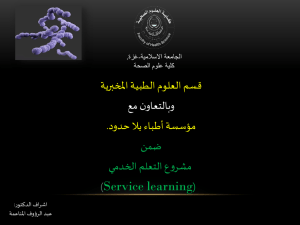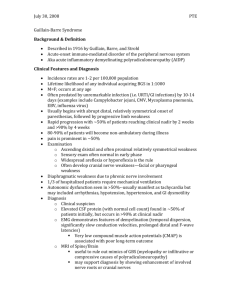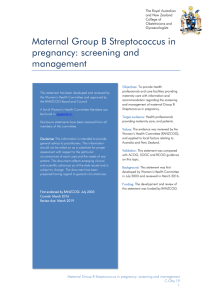Betamethasone - 12 mg IM Q 24 hours X 2 doses 1 24
advertisement
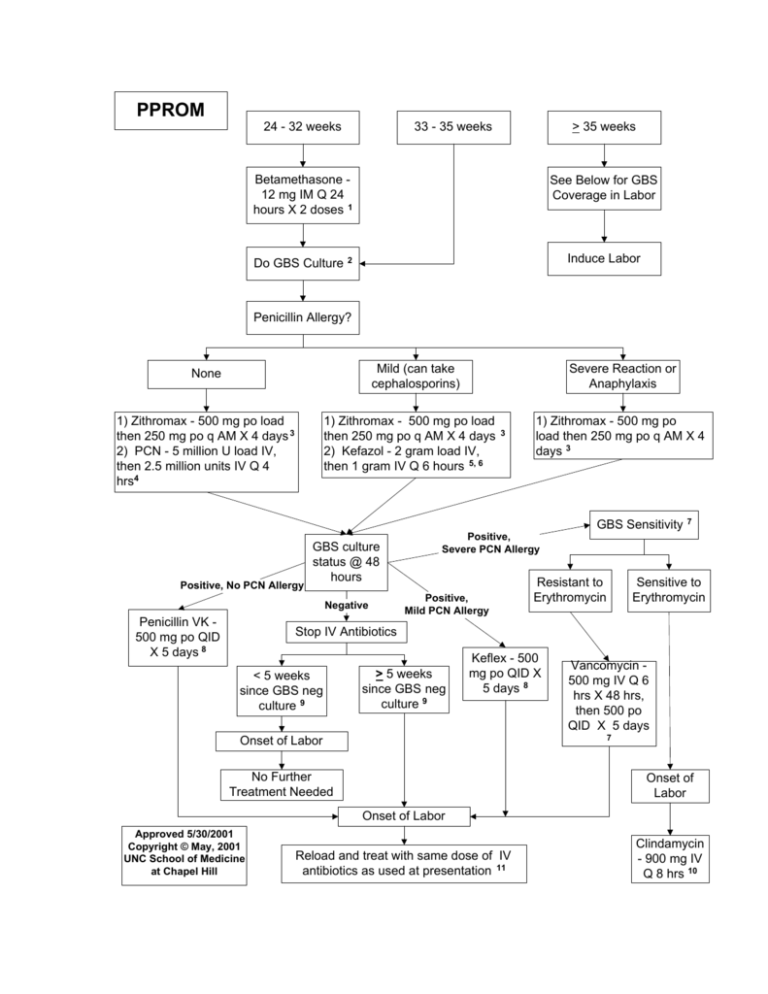
PPROM 24 - 32 weeks 33 - 35 weeks > 35 weeks Betamethasone 12 mg IM Q 24 hours X 2 doses 1 Do GBS Culture See Below for GBS Coverage in Labor Induce Labor 2 Penicillin Allergy? Mild (can take cephalosporins) None 1) Zithromax - 500 mg po load then 250 mg po q AM X 4 days 3 2) PCN - 5 million U load IV, then 2.5 million units IV Q 4 hrs4 1) Zithromax - 500 mg po load then 250 mg po q AM X 4 days 2) Kefazol - 2 gram load IV, then 1 gram IV Q 6 hours 5, 6 Positive, No PCN Allergy GBS culture status @ 48 hours Negative Penicillin VK 500 mg po QID X 5 days 8 Severe Reaction or Anaphylaxis 3 1) Zithromax - 500 mg po load then 250 mg po q AM X 4 days 3 Positive, Severe PCN Allergy Positive, Mild PCN Allergy GBS Sensitivity Resistant to Erythromycin 7 Sensitive to Erythromycin Stop IV Antibiotics < 5 weeks since GBS neg culture 9 > 5 weeks since GBS neg culture 9 Keflex - 500 mg po QID X 5 days 8 Vancomycin 500 mg IV Q 6 hrs X 48 hrs, then 500 po QID X 5 days 7 Onset of Labor No Further Treatment Needed Onset of Labor Onset of Labor Approved 5/30/2001 Copyright © May, 2001 UNC School of Medicine at Chapel Hill Reload and treat with same dose of IV antibiotics as used at presentation 11 Clindamycin - 900 mg IV Q 8 hrs 10 controversies. Obstet Gynecol 2000;96:141- 5. ….. a first generation cephalosporin might be an acceptable choice for women allergic to penicillin without a history of anaphylaxis, because GBS resistance to cephalosporins has not been identified. PPROM References: 1) ACOG Committee Opinion # 210, October, 1998. Antenatal corticosteroid therapy for fetal maturation. Antenatal corticosteroid use is recommended in women with preterm premature rupture of membranes at less than 30-32 weeks of gestation in the absence of clinical chorioamnionitis because of the high risk of intraventricular hemorrhage at these early gestational ages. 2) ACOG Committee Opinion # 173, June 1996. Prevention of early-onset group B streptococcal disease in newborns. Evidence is also insufficient to recommend a single course of management when a woman has preterm PROM at less than 37 weeks of gestation. Culture for GBS should be obtained in all women with preterm PROM. Following culture, antibiotic prophylaxis may be withheld. Antibiotics should be started if positive culture results are obtained or if labor begins before culture results are available. An acceptable alternative approach is to initiate prophylactic antibiotics until culture results are available. Treatment can be discontinued if the culture is negative for GBS. The appropriate duration of treatment for patients who have preterm PROM and positive GBS cultures has not been determined. 3) Kenyon SL, Taylor DJ, Tarnow-Mordi W; ORACLE Collaborative Group. Broad-spectrum antibiotics for preterm, prelabour rupture of fetal membranes: the ORACLE I randomised trial. Lancet 2001; 357:97988. Erythromycin for women with PPROM is associated with a range of health benefits for the neonate, and thus a probably reduction in childhood disability. 4) ACOG Committee Opinion # 173, June 1996. Prevention of early-onset group B streptococcal disease in newborns. For intrapartum chemoprophylaxis, use intravenous penicillin G (5 million units initially and then 2.5 million units every 4 hours) until delivery. 5) Bland ML, Vermillion ST, Soper DE, Austin M. Antibiotic resistance patterns of group B streptococci in late third trimester rectovaginal cultures. Am J Obstet Gynecol 2001;184:1125-6. A total of 2111 pregnant women were screened for rectovaginal colonization of GBS … clindamycin and erythromycin had 8% and 19% respectively of the GBS isolates demonstrating a resistant pattern. Cefazolin revealed a 98.1% sensitive pattern, 1.8% intermediate sensitivity pattern and 0.06% resistant pattern. 6) Hager WD, Schuchat A, Gibbs R, Sweet R, Mead P, Larsen JW. Prevention of perinatal group B streptococcal infection: current 7) Hager WD, Schuchat A, Gibbs R, Sweet R, Mead P, Larsen JW. Prevention of perinatal group B streptococcal infection: current controversies. Obstet Gynecol 2000;96:141- 5. Among women with a history of anaphylaxis ot penicillin, we recommend that susceptibility testing to clindamycin and erythromicin be requested for any positive GBS culture. If the organism is resistant, vancomycin would be the better choice than a cephalosporin. 8) Hager WD, Schuchat A, Gibbs R, Sweet R, Mead P, Larsen JW. Prevention of perinatal group B streptococcal infection: current controversies. Obstet Gynecol 2000;96:141- 5. … intravenous antibiotics should be given for an additional 5 – 7 days. 9) Yancey MK, Schhchat A, Brown LK, Ventura VL, Markenson GR. The accuracy of late antenatal screening cultures in predicting genital group B streptococcal colonization during delivery. Obstet Gynecol 1996;88:811-5. Test performance was significantly better for cultures collected within 5 weeks of delivery compared with those collected at longer intervals before delivery… 10) ACOG Committee Opinion # 173, June 1996. Prevention of early-onset group B streptococcal disease in newborns. Clindamycin or erythromycin may be used for women allergic to penicillin… 11) Hager WD, Schuchat A, Gibbs R, Sweet R, Mead P, Larsen JW. Prevention of perinatal group B streptococcal infection: current controversies. Obstet Gynecol 2000;96:141- 5. Any patient with a positive culture should still receive intrapartum antibiotics. NOTIFICATION TO USERS These algorithms are designed to assist the primary care provider in the clinical management of a variety of problems that occur in pregnancy. They should not be interpreted as standard of care but instead represent guidelines for the management of these patients. Variation in practice should be taken into account such factors as characteristics of the individual patient, health resources, and regional experience with diagnostic and therapeutic modalities. The algorithms remain the intellectual property of the University of North Carolina School of Medicine at Chapel Hill. They cannot be reproduced in whole or part without the expressed permission of the school. Copyright © August 2001 UNC School of Medicine at Chapel Hill


